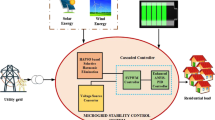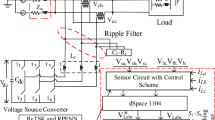Abstract
This paper proposes the neural network (NN) predictive controller that combines the advantages of NN and predictive control for the automatic voltage regulator (AVR). The NN predictive controller is suggested as a new intelligence controller rather than the conventional controllers for the AVR. This is the first application of the NN predictive controller for AVR. There are five parameters of the NN predictive controller which need a proper tuning to get a good performance by using the NN predictive controller. In recent papers, the parameters of NN predictive controller are typically set by trial and error or by the designer’s expertise. The imperialist competitive algorithm (ICA) is introduced in this paper as a new artificial intelligence technique instead of the trial-and-error or the designer’s expertise methods to get the optimal parameters of NN predictive controller in order to overcome the deviations of the voltage. The performance of the designed NN predictive controller based on the ICA is compared with the designed NN predictive controller based on the genetic algorithm and the conventional proportional–integral–derivative controller based on Ziegler–Nichols technique. The comparison emphasizes the superiority of the suggested NN predictive controller based on the ICA.














Similar content being viewed by others
Abbreviations
- N 1 :
-
The minimal prediction horizon of the output
- N 2 :
-
The maximal prediction horizon of the output
- N u :
-
The control horizon
- u′:
-
Tentative control signal
- y r :
-
The target response
- y m :
-
The network model response
- ρ :
-
The weight of the control signal
- β :
-
A number > 1
- d :
-
The distance between colony and imperialist
- γ :
-
A limit angle
- V ref :
-
The reference voltage
- V t :
-
The output terminal voltage
- e :
-
The error signal
- u :
-
The control signal
- K A :
-
The amplifier gain
- T A :
-
The amplifier time constant
- K E :
-
The exciter gain
- T E :
-
The exciter time constant
- K G :
-
The generator gain
- T G :
-
The generator time constant
- K S :
-
The sensor gain
- T S :
-
The sensor time constant
References
Kundur P (1994) Power system stability and control. McGraw-Hill, New York
Saadat H (2002) Power system analysis. Tata Mcgraw-Hill, New Delhi
Chatterjee S, Mukherjee V (2016) PID controller for automatic voltage regulator using teaching–learning based optimization technique. Int J Electr Power Energy Syst 77:418–429
Hasanien HM (2013) Design optimization of PID controller in automatic voltage regulator system using Taguchi combined genetic algorithm method. IEEE Syst J 7(4):825–831
Devaraj D, Selvabala B (2009) Real-coded genetic algorithm and fuzzy logic approach for real-time tuning of proportional–integral–derivative controller in automatic voltage regulator system. IET Gener Transm Distrib 3(7):641–649
Kansit S, Assawinchaichote W (2016) Optimization of PID controller based on PSOGSA for an automatic voltage regulator system. Procedia Comput Sci 86:87–90
Gaing ZL (2004) A particle swarm optimization approach for optimum design of PID controller in AVR system. IEEE Trans Energy Convers 19(2):384–391
Panda S, Sahu BK, Mohanty PK (2012) Design and performance analysis of PID controller for an automatic voltage regulator system using simplified particle swarm optimization. J Frankl Inst 349(8):2609–2625
Chatterjee A, Mukherjee V, Ghoshal SP (2009) Velocity relaxed and craziness-based swarm optimized intelligent PID and PSS controlled AVR system. Int J Electr Power Energy Syst 31(7):323–333
Kim DH, Cho JH (2006) A biologically inspired intelligent PID controller tuning for AVR systems. Int J Control Autom Syst 4(5):624–636
Dos Santos Coelho L (2009) Tuning of PID controller for an automatic regulator voltage system using chaotic optimization approach. Chaos, Solitons Fractals 39(4):1504–1514
Aguila-Camacho N, Duarte-Mermoud MA (2013) Fractional adaptive control for an automatic voltage regulator. ISA Trans 52(6):807–815
Prasad LB, Gupta HO, Tyagi B (2014) Application of policy iteration technique based adaptive optimal control design for automatic voltage regulator of power system. Int J Electr Power Energy Syst 63:940–949
Zhang H, Shi F, Liu Y (2014) Enhancing optimal excitation control by adaptive fuzzy logic rules. Int J Electr Power Energy Syst 63:226–235
Hasan AR, Martis TS, Ula AS (1994) Design and implementation of a fuzzy controller based automatic voltage regulator for a synchronous generator. IEEE Trans Energy Convers 9(3):550–557
Li H, Li F, Xu Y, Rizy DT, Kueck JD (2010) Adaptive voltage control with distributed energy resources: algorithm, theoretical analysis, simulation, and field test verification. IEEE Trans Power Syst 25(3):1638–1647
Mao C, Malik OP, Hope GS, Fan J (1990) An adaptive generator excitation controller based on linear optimal control. IEEE Trans Energy Convers 5(4):673–678
Camacho E, Bordons C (2004) Model predictive control. Springer, Berlin
Farina M, Guagliardi A, Mariani F, Sandroni C, Scattolini R (2015) Model predictive control of voltage profiles in MV networks with distributed generation. Control Eng Pract 34:18–29
Amraee T, Ranjbar AM, Feuillet R (2011) Adaptive under-voltage load shedding scheme using model predictive control. Electr Power Syst Res 81(7):1507–1513
Kassem AM, Yousef AM (2013) Voltage and frequency control of an autonomous hybrid generation system based on linear model predictive control. Sustain Energy Technol Assess 4:52–61
Hassan LH, Moghavvemi M, Almurib HA, Steinmayer O (2013) Current state of neural networks applications in power system monitoring and control. Int J Electr Power Energy Syst 51:134–144
Kassem AM (2010) Neural predictive controller of a two-area load frequency control for interconnected power system. Ain Shams Eng J 1(1):49–58
Lachman T, Mohamad TR (2009) Neural network excitation control system for transient stability analysis of power system. In: TENCON 2009-2009 IEEE Region 10 Conference. IEEE, pp 1–6
Bahmanyar AR, Karami A (2014) Power system voltage stability monitoring using artificial neural networks with a reduced set of inputs. Int J Electr Power Energy Syst 58:246–256
Suykens JAK (1996) Artificial neural networks for modelling and control of non-linear systems, 1st edn. Kluwer Academic Publishers, Boston
Fausett L (1994) Fundamentals of neural networks, architectures, algorithms and applications, 2nd edn. Prentice Hall, Englewood Cliffs
Yan G, Li C (2011) An effective refinement artificial bee colony optimization algorithm based on chaotic search and application for PID control tuning. J Comput Inf Syst 7(9):3309–3316
Abachizadeh M, Yazdi MRH, Yousefi-Koma A (2010) Optimal tuning of PID controllers using artificial bee colony algorithm. In: 2010 IEEE/ASME international conference on advanced intelligent mechatronics (AIM), pp 379–384
Kumar SR, Ganapathy S (2014) Artificial cooperative search algorithm based load frequency control of deregulated power system with SMES unit. J Theor Appl Inf Technol 63(1):20–29
Walters DC, Sheble GB (1993) Genetic algorithm solution of economic dispatch with valve point loading. IEEE Trans Power Syst 8(3):1325–1332
Elsisi M, Soliman M, Aboelela MAS, Mansour W (2016) Bat inspired algorithm based optimal design of model predictive load frequency control. Int J Electr Power Energy Syst 83:426–433
Ghoshal SP (2004) Optimizations of PID gains by particle swarm optimizations in fuzzy based automatic generation control. Electr Power Syst Res 72(3):203–212
Elsisi M, Soliman M, Aboelela MAS, Mansour W (2017) Model predictive control of plug-in hybrid electric vehicles for frequency regulation in a smart grid. IET Gener Transm Distrib 11(16):3974–3983
Ardalan Z, Karimi S, Poursabzi O, Naderi B (2015) A novel imperialist competitive algorithm for generalized traveling salesman problems. Appl Soft Comput 26:546–555
Ogata K (2001) Modern control engineering. Prenctice Hall, Upper Saddle River
Kumar A, Kumar A, Chanana S (2010) Genetic fuzzy PID controller based on adaptive gain scheduling for load frequency control. In: 2010 Joint international conference on power electronics, drives and energy systems (PEDES) & 2010 power India. IEEE, pp 1–8
Selvakumaran S, Rajasekaran V, Karthigaivel R (2014) Genetic algorithm tuned IP controller for Load Frequency Control of interconnected power systems with HVDC links. Arch Electr Eng 63(2):161–175
Dwivedi A, Ray G, Sharma AK (2016) Genetic algorithm based decentralized PI type controller: load frequency control. J Inst Eng (India) Ser B 97(4):509–515
Soheilirad M, Karami K, Othman ML, Farzan P (2013) PID controller adjustment for MA-LFC by using a hybrid Genetic-Tabu Search Algorithm. In: System engineering and technology (ICSET), 2013 IEEE 3rd international conference on IEEE 2013, pp 197–202
Mahto T, Mukherjee V (2015) Frequency stabilisation of a hybrid two-area power system by a novel quasi-oppositional harmony search algorithm. Proc IET Gener Transm Distrib 9(15):2167–2179
Ghoshal SP, Roy R (2008) Evolutionary computation based comparative study of TCPS and CES control applied to automatic generation control. In: Power system technology and IEEE power India conference, 2008. POWERCON 2008
Atashpaz-Gargari E, Lucas C (2007) Designing an optimal PID controller using Imperialist Competitive Algorithm. In: First joint congress on fuzzy and intelligent systems. Ferdowsi University of Mashhad, pp 29–31
Atashpaz-Gargari, E, Lucas C (2007) Imperialist competitive algorithm: an algorithm for optimization inspired by imperialistic competition. In: IEEE congress on evolutionary computation, 2007. CEC 2007, pp 4661–4667
Author information
Authors and Affiliations
Corresponding author
Ethics declarations
Conflict of interest
Author states that there are no conflicts of interest.
Ethical approval
This article does not contain any studies with human participants performed by any of the authors.
Additional information
Publisher's Note
Springer Nature remains neutral with regard to jurisdictional claims in published maps and institutional affiliations.
Appendix
Appendix
The typical values of AVR system are given below [2]:
where boundary values of the plant variables are given below [3]:
Imperialist algorithm parameters: number of countries = 100; number of initial imperialists = 2; number of iteration = 100.
Genetic algorithm parameters: The genetic algorithm in the MATLAB toolbox is used with its default parameters.
Rights and permissions
About this article
Cite this article
Elsisi, M. Design of neural network predictive controller based on imperialist competitive algorithm for automatic voltage regulator. Neural Comput & Applic 31, 5017–5027 (2019). https://doi.org/10.1007/s00521-018-03995-9
Received:
Accepted:
Published:
Issue Date:
DOI: https://doi.org/10.1007/s00521-018-03995-9




